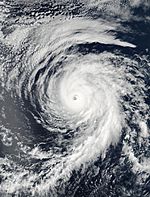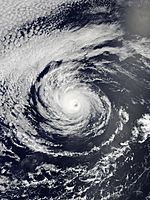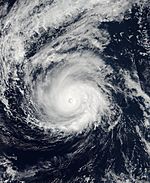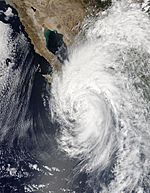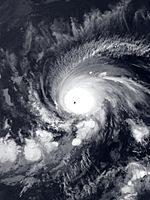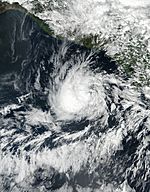The 2016 Pacific hurricane season was a time when many powerful storms formed over the Pacific Ocean. These storms are also known as tropical cyclones. The season officially started on May 15, 2016, for the eastern Pacific. This area is east of a special line called 140°W longitude. For the central Pacific, the season began on June 1, 2016. This area is between the International Date Line and 140°W. Both parts of the season officially ended on November 30, 2016. These dates are when most tropical cyclones usually form in the eastern Pacific.
Understanding Tropical Cyclones
Tropical cyclones are huge spinning storms. They form over warm ocean waters. They bring strong winds and heavy rain. When these storms get very strong, they are called hurricanes. The 2016 season saw many such storms.
How Storms Are Measured
Scientists measure storms in different ways. They look at the wind speed and the air pressure.
- Wind speed: This tells us how fast the winds are blowing. It helps classify a storm as a tropical depression, tropical storm, or hurricane.
- Pressure: This is the air pressure at the center of the storm. Lower pressure usually means a stronger storm.
Key Storms of 2016
The 2016 Pacific hurricane season had 20 named storms in the eastern Pacific. There were also two storms in the central Pacific. Six of these storms became major hurricanes. A major hurricane has very strong winds.
Hurricane Pali: An Early Start
| Category 2 hurricane (SSHS) |
|
|
| Duration |
January 7 – January 15 |
| Intensity |
100 mph (155 km/h) (1-min), 977 mbar (hPa) |
Hurricane Pali was unusual because it formed very early. It began on January 7, 2016. This was long before the official start of the season. Pali reached its strongest winds at 85 miles per hour. It lasted for about a week.
Hurricane Blas: A Powerful July Storm
| Category 4 hurricane (SSHS) |
|
|
| Duration |
July 2 – July 10 |
| Intensity |
140 mph (220 km/h) (1-min), 947 mbar (hPa) |
Hurricane Blas was one of the strongest storms in July. It formed on July 2, 2016. Blas had winds up to 120 miles per hour. It was a powerful storm that lasted for eight days.
Hurricane Darby: Long-Lasting and Strong
| Category 3 hurricane (SSHS) |
|
|
| Duration |
July 11 – July 26 |
| Intensity |
120 mph (195 km/h) (1-min), 958 mbar (hPa) |
Hurricane Darby was a long-lasting storm. It formed on July 11, 2016. Darby stayed active for over two weeks. Its winds reached 105 miles per hour.
Hurricane Lester: A Major Threat
| Category 4 hurricane (SSHS) |
|
|
| Duration |
August 24 – September 7 |
| Intensity |
145 mph (230 km/h) (1-min), 944 mbar (hPa) |
Hurricane Lester was a very strong storm. It formed on August 24, 2016. Lester had winds of 125 miles per hour. It was one of the most powerful hurricanes of the season.
Hurricane Madeline: Close to Land
| Category 4 hurricane (SSHS) |
|
|
| Duration |
August 26 – September 3 |
| Intensity |
130 mph (215 km/h) (1-min), 950 mbar (hPa) |
Hurricane Madeline formed on August 26, 2016. It reached winds of 115 miles per hour. Madeline caused concern as it passed close to land areas.
Hurricane Newton: Impacting Mexico
| Category 1 hurricane (SSHS) |
|
|
| Duration |
September 4 – September 7 |
| Intensity |
90 mph (150 km/h) (1-min), 977 mbar (hPa) |
Hurricane Newton formed on September 4, 2016. It had winds of 80 miles per hour. Newton made landfall in Mexico. It caused some damage and affected people there.
Hurricane Seymour: The Strongest Storm
| Category 4 hurricane (SSHS) |
|
|
| Duration |
October 23 – October 28 |
| Intensity |
150 mph (240 km/h) (1-min), 940 mbar (hPa) |
Hurricane Seymour was the strongest storm of the season. It formed on October 23, 2016. Seymour had incredible winds of 130 miles per hour. Its pressure was also the lowest, at 940 millibars. This made it a very intense hurricane.
Tropical Storm Otto: A Rare Crossover
| Tropical storm (SSHS) |
|
|
| Duration |
November 25 (Entered basin) – November 26 |
| Intensity |
70 mph (110 km/h) (1-min), 993 mbar (hPa) |
Tropical Storm Otto was unique. It formed in the Atlantic Ocean. Then, it crossed over into the Pacific Ocean. This is a very rare event for a storm. It dissipated on November 26, 2016.
Overall Impact of the Season
The 2016 Pacific hurricane season was quite active. It had a total of 22 tropical storms. Six of these became major hurricanes. Sadly, these storms led to some unfortunate events. There were 11 reported fatalities. The storms also caused about $96 million in damages. This shows how powerful and impactful these natural events can be.
Related pages
Images for kids
-
Four simultaneous tropical cyclones existed on July 22. From left to right: Darby, Estelle, Eight-E (which would soon become Georgette), and Frank
See also
 In Spanish: Temporada de huracanes en el Pacífico de 2016 para niños
In Spanish: Temporada de huracanes en el Pacífico de 2016 para niños
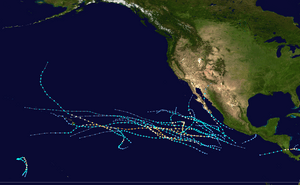
 In Spanish: Temporada de huracanes en el Pacífico de 2016 para niños
In Spanish: Temporada de huracanes en el Pacífico de 2016 para niños



